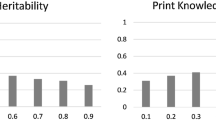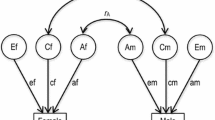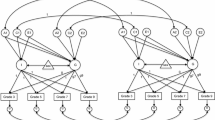Abstract
We have initiated parallel longitudinal studies in Australia (Byrne, PI), the United States (Olson, PI), and Norway (Samuelsson, PI) of identical and fraternal twins who are being tested in preschool for prereading skills, and in kindergarten, first grade, and second grade for the development of early reading, spelling, and related cognitive skills. Comparisons of the similarities of identical and fraternal twins will reveal the relative influence of genetic, shared family environment, and nonshared environment on individual differences at and across different stages of development. Family and twin-specific environmental information is also being directly assessed through parent questionnaires and observations by testers. Most of the data collected so far have been from preschool twins (146 in Australia, 284 in the United States, and 70 in Norway). Preliminary analyses for the preschool cognitive measures showed reliable genetic influences on phonological awareness and several measures of memory and learning. In contrast, vocabulary, grammar, and morphology showed significant shared environment and negligible genetic effects. A print knowledge composite showed both genetic and shared environment influence.
Similar content being viewed by others
References
Adams, M. J. (1990). Beginning to read: Thinking and learning about print. Cambridge, MA: MIT Press.
Adams, W., & Sheslow, D. (1990). Wide range assessment of memory and learning. Wilmington, DE: Jastak Associates.
Berko, J. (1958). The child’s learning of English morphology. Word, 14, 47–56.
Boada, R., Willcutt, E. G., Tunick, R. A., Chhabildas, N. A., Olson, R. K., DeFries, J. C., & Pennington, B. F. (in press). A twin study of the etiology of high reading ability. Reading and Writing: An Interdisciplinary Journal.
Bradley, D. (1999). Personal communication.
Bradley, L., & Bryant, P. E. (1983). Categorising sounds and learning to read—A causal connection. Nature, 301, 419–421.
Byrne, B. (1998). The foundation of literacy: The child’s acquisition of the alphabetic principle. Hove, UK: Psychology Press.
Byrne, B., & Fielding-Barnsley, R. (1989). Phonemic awareness and letter knowledge in the child’s acquisition of the alphabetic principle. Journal of Educational Psychology, 81, 313–321.
Byrne, B., & Fielding-Barnsley, R. (1990). Acquiring the alphabetic principle: A case for teaching recognition of phoneme identity. Journal of Educational Psychology, 82, 805–812.
Byrne, B., & Fielding-Barnsley, R. (1991). Evaluation of a program to teach phonemic awareness to young children. Journal of Educational Psychology, 83, 451–455.
Byrne, B., Fielding-Barnsley, R., & Ashley, L. (2000). Effects of preschool phoneme identity training after six years: Outcome level distinguished from rate of response. Journal of Educational Psychology, 92, 659–667.
Byrne, B., Fielding-Barnsley, R., Ashley, L., & Larsen, K. (1997). Assessing the child’s and the environment’s contribution to reading acquisition: What we know and what we don’t know. In B. Blachman (Ed.), Foundations of reading acquisition and dyslexia: Implications for early intervention (pp. 265–285). Mahwah, NJ: Lawrence Erlbaum Associates.
Carlisle, J. F. (1987). The use of morphological knowledge in spelling derived forms by learning-disabled and normal students. Annals of Dyslexia, 27, 90–108.
Catts, H. W. (1989). Speech production deficits in developmental dyslexia. Journal of Speech and Hearing Disorders, 54, 422–428.
Catts, H. W. (1993). The relationship between speech-language impairments and reading disabilities. Journal of Speech and Hearing Research, 36, 948–958.
Clay, M. (1975). The early detection of reading difficulties: A diagnostic survey. Auckland, New Zealand: Heinemann.
Davis, C. J., Knopik, V. S., Olson, R. K., Wadsworth, S. J., & DeFries, J. C. (2001). Genetic and environmental influences on rapid naming and reading ability: A twin study. Annals of Dyslexia, 51, 241258.
DeFries, J. C., & Alarcon, M. (1996). Genetics of specific reading disability. Mental Retardation and Developmental Dissabilities Research Reviews, 2, 3947.
DeFries, J. C., Alarcon, M., & Olson, R. K. (1997). Genetics and dyslexia: Developmental differences in the etiologies of reading and spelling deficits. In C. Hulme & M. Snowling (Eds.), Dyslexia: Biological bases, identification, & intervention (pp. 20–37). London: Whurr Publishing.
Elbro, C., Borstrøm, I., & Petersen, D. K. (1998). Predicting dyslexia from kindergarten: The importance of distinctness of phonological representations of lexical items. Reading Research Quarterly, 33, 36–60.
Fischer, K. M. (1973). A comparison of the similarities in language skills of identical and fraternal twins. Unpublished doctoral dissertation. University of Pennsylvania, Philadelphia.
Fisher, S. E., Francks, C., Marlow, A. J., MacPhie, L., Williams, D. F., Cardon, L. R., Ishikawa-Brush, Y., Talcott, J. B., Richardson, A. J., Gayán, J., Olson, R. K., Pennington, B. F., Smith, S. D., DeFries, J. C., Stein, J. F., & Monaco, A. P. (2002). Genome-wide scans in independent samples reveal strong convergent evidence for a chromosome 18 quantitative-trait locus influencing developmental dyslexia. Nature Genetics, 30, 86–91.
Fisher, J. P., & Glenister, J. M. (1992). The hundred pictures naming test. Hawthorn, Australia: Australian Council for Educational Research.
Foch, T. T., & Plomin, R. (1980). Specific cognitive abilities in 5- to 12-year-old twins. Behavior Genetics, 10, 507–520.
Gallagher, A., Frith, U., & Snowling, M. J. (2000). Precursors of literacy delay among children at genetic risk for dyslexia. Journal of Child Psychology and Psychiatry, 41, 203–213.
Gathercole, S. E., & Adams, A. (1993). Phonological working memory in very young children. Developmental Psychology, 29, 770–778.
Gathercole, S., & Baddeley, A. (1989). Evaluation of the role of phonological STM in the development of vocabulary in children: A longitudinal study. Journal of Memory and Language, 28, 200–213
Gathercole, S., & Baddeley, A, (1996). The children’s test of nonword repetition-revised. New York: Harcourt.
Gayán, J., & Olson, R. K. (2001). Genetic and environmental influences on orthographic and phonological skills in children with reading disabilities. Developmental Neuropsychology, 20(2), 487–511.
Gayán, J., & Olson, R.K. (under review). Genetic and environmental influences in individual differences in printed word recognition.
Gayán, J., Smith, S. D., Cherny, S. S., Cardon, L. R., Fulker, D. W., Kimberling, W. J., Olson, R. K., Pennington, B., & DeFries, J. C. (1999). Large quantitative trait locus for specific language and reading deficits in chromosome 6p. American Journal of Human Genetics, 64, 157–164.
Grigorenko, E. L., & Sternberg, R. J. (1998). Dynamic Testing. Psychological Bulletin, 124, 75–111.
Hindson, B. A. (2001). Linguistic and cognitive characteristics of preschool children at risk for reading disability. Unpublished doctoral dissertation. University of New England, Armidale, NSW, Australia.
Lonigan, C. R. (2000). Personal communication.
Lyytinen, H. (1997). In search of the precursors of dyslexia: A prospective study of children at risk for reading problems. In C. Hulme & M. Snowling (Eds.), Dyslexia: Biology, cognition and intervention (pp. 97–107). London: Whurr.
Man, J. (2000). Alpha beta: How 26 letters shaped the western world. New York: John Wiley.
Mather, P. L., & Black, K. N. (1984). Hereditary and environmental influences on preschool twins’ language skills. Developmental Psychology, 20, 303–308.
McCarthy, J. J., & Kirk, S. A. (1961). The Illinois test of psycholinguistic abilities. Urbana, IL: University of Illinois Press.
Morais, J., Cary, L., Alegria, J., & Bertelson, P. (1979). Does awareness of speech as a sequence of phonemes arise spontaneously? Cognition, 7, 323–331.
Neale, M. C. (1999). Mx: Statistical modeling (5th ed.). Richmond, VA: Department of Psychiatry.
Neale, M. C., & Cardon, L. R. (1992). Methodology for genetic studies of twins and families, NATO ASI series. Dordrecht, The Netherlands: Kluwer Academic Press.
Nichols, R. C., & Bilbro, W. C., (1966). The diagnosis of twin zygosity. Acta Genetica, 16, 265–275.
Olson, R. K., Forsberg, H., & Wise, B. (1994). Genes, environment, and the development of orthographic skills. In V. W. Berninger (Ed.), The varieties of orthographic knowledge I: Theoretical and developmental issues (pp. 27–71). Dordrecht, The Netherlands: Kluwer Academic Publishers.
Olson, R. K., Wise, B., Conners, F., Rack, J., & Fulker, D. (1989). Specific deficits in component reading and language skills: Genetic and environmental influences. Journal of Learning Disabilities, 22, 339–348.
Pennington, B. F., & Lefly, D. L. (2001). Early reading development in children at family risk for dyslexia. Child Development, 72, 816–833.
Sattler, J.M. (1988). Assessment of children. San Diego, CA: Jerome M. Sattler, Publisher.
Scarborough, H. S. (1991a). Early syntactic development of dyslexic children. Annals of Dyslexia, 41, 207–220.
Scarborough, H. S. (1991b). Antecedents to reading disability: Preschool language development and literacy experiences of children from dyslexic families. Reading and Writing, 3, 219–233.
Scarborough, H. S. (1998). Early detection of children at risk for reading disabilities: Phonological awareness and other promising predictors. In B. K. Shapiro, P. J. Accardo, & A. J. Capute (Eds.), Specific reading disability: A view of the spectrum (pp. 75–119). Timonium, MD: York Press.
Segal, N. L. (2000). Entwined Lives: Twins and what they tell us about human behavior. New York: Plume.
Stromswold, K. (2001). The heritability of language: A review and metaanalysis of twin, adoption, and linkage studies. Language, 77, 647–723.
Swanson, H. L., & Siegel, L. (2001). Learning disabilities as a working memory deficit. Issues in Education, 7, 1–48.
Wagner, R. K., Torgesen, J. K., & Rashotte, C. A. (1999). The comprehensive test of phonological processes (CTOPP). Austin, TX: PRO-ED.
Wechsler, D. (1989). Manual for the Wechsler preschool and primary scale of intelligence-revised. New York: Psychological Corporation.
Wilcutt, E. G., Pennington, B. F., Smith, S. D., Cardon, L. R., Gayn, J., Knopic, V. S., Olson, R. K., & DeFries, J. C. (2002). Quantitative trait locus for reading disability on chromosome 6p is pleiotropic for attention-deficit/hyperactivity disorder. American Journal of Medical Genetics (Neuropsychiatric Genetics), 114, 260–268.
Wolf, M., & Bowers, P. (1999). The question of naming-speed deficits in developmental reading disabilities: An introduction to the double-deficit hypothesis. Journal of Educational Psychology, 91, 1–24.
Woodcock, R. W. (1987). Woodcock reading mastery tests-revised. Circle Pines, MN: American Guidance Service.
Author information
Authors and Affiliations
Corresponding authors
Rights and permissions
About this article
Cite this article
Byrne, B., Delaland, C., Fielding-Barnsley, R. et al. Longitudinal twin study of early reading development in three countries: Preliminary results. Ann. of Dyslexia 52, 47–73 (2002). https://doi.org/10.1007/s11881-002-0006-9
Issue Date:
DOI: https://doi.org/10.1007/s11881-002-0006-9




